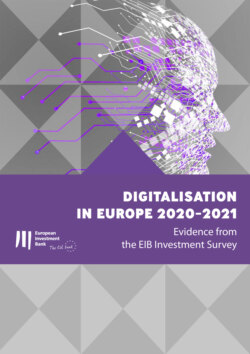Читать книгу Digitalisation in Europe 2020-2021 - Группа авторов - Страница 7
ОглавлениеThe EIB Corporate Digitalisation Index
The EIBIS Corporate Digitalisation Index explores the degree of digital adoption in the European Union and the United States from various perspectives. This composite index summarises indicators on digitalisation as well as firms’ assessments of digital infrastructure and investments. The EIBIS Corporate Digitalisation Index consists of six components: digital intensity, digital infrastructure, investment in software and data, investment in organisational and business process improvements, the use of a strategic monitoring system, and the digital outlook. It is based on firm-level data collected by EIBIS in 2020. Appendix A contains more details on the components and how the index has been constructed.
The EIBIS Corporate Digitalisation Index allows us to group countries according to firms’ assessment of digitalisation: frontrunners, strong, moderate and modest. Based on the index, Denmark and the Netherlands are the top two digital countries, followed by Finland and Sweden.
EIBIS Corporate Digitalisation Index
Source: EIBIS (2020).
Note: Firms are weighted using value added.
EIBIS Corporate Digitalisation Index key findings:
• The European Union, on average, falls short of the United States. There are, however, several EU countries that outperform the United States. European firms implement the internet of things technologies less often and are lagging behind in the construction sector in particular, which drags down the digital intensity score. What is more, EU firms tend to perceive digital infrastructure as a major obstacle to investment more often.
• The top performing EU countries, in selected areas of digitalisation, are: Denmark for digital intensity as well as investment in software and data; France for investments in organisation and business process improvements; Finland for the use of a formal strategic business monitoring system, Germany for the digital outlook; and the Netherlands for digital infrastructure. These results suggest that there is potential even for the best performers in one component of the Corporate Digitalisation Index to improve their performance further in the other dimensions.
EIBIS Corporate Digitalisation Index, by country
Source: EIBIS (2020).
Note: Firms are weighted using value added.
The EIBIS Corporate Digitalisation Index rounds out the European Commission’s Digitalisation Economy and Society Index (DESI) by adding the unique perception of firms. However, the two indices display a strong positive correlation across countries. The main differences between the two are:
• All six components of the EIBIS Corporate Digitalisation Index are based on firms’ assessment of digitalisation and questions from the same survey, which makes it easy to make comparisons across countries. The various components of DESI combine data on households, individuals, e-government services and enterprises from different sources and data providers.
• DESI does not include US firms, yet their data are of paramount importance for the analysis of the digitalisation gap or the digital divide between the European Union and the United States.
• The DESI component on the integration of digital technology captures firms’ use of digitalisation and e-commerce, but examines different technologies from the digital intensity component of the EIBIS Corporate Digitalisation Index, which focuses on the use of more advanced digital technologies. Appendix B compares digital technologies covered by both EIBIS and Eurostat and shows a high positive correlation across countries for the share of firms reporting that they use these technologies.
• The infrastructure component of the EIBIS Corporate Digitalisation Index captures whether firms consider digital infrastructure as an obstacle to their investment activities, whereas the connectivity component of DESI captures household connectivity by broadband market developments in the European Union. Appendix B shows a strong correlation across countries for the two measures.
• The EIBIS Corporate Digitalisation Index does not cover human capital and digital public services, in contrast to DESI. However, the EIBIS index does capture whether firms use formal strategic business monitoring systems, which is an indicator of management practice. Similarly, as EIBIS is dedicated to firms, it does not cover citizens’ use of internet services and online transactions, which are included in DESI.
DESI and EIBIS Corporate Digitalisation Index, by country
Source: European Commission’s Digital Economy and Society Index (DESI) and EIBIS (2020).
Note: Firms in EIBIS are weighted using value added.
